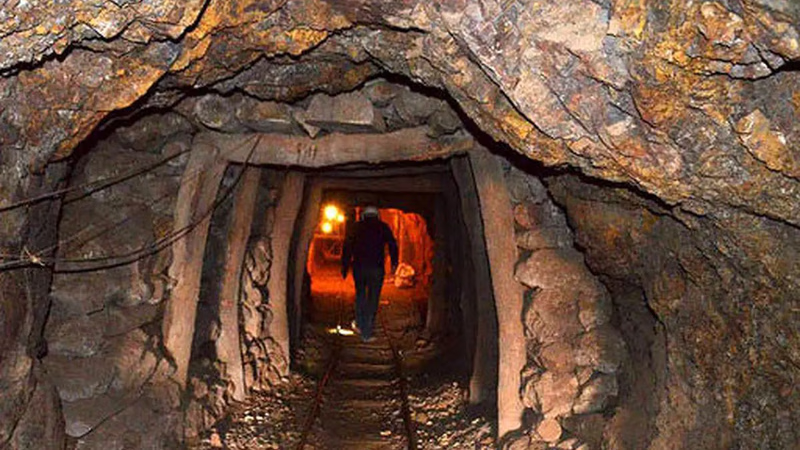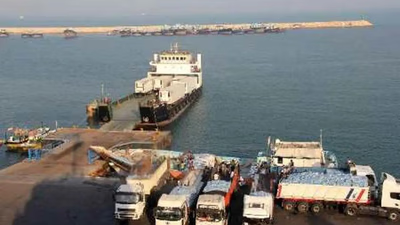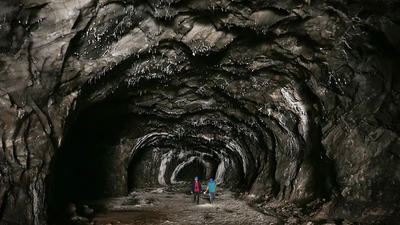
Mineral resources in the Middle East: Bauxite and Hematite.
Bauxite is the primary source of aluminum and is used in the production of various aluminum products. Significant bauxite deposits are found in countries such as Iran, Saudi Arabia, and Turkey. Phosphate rock is an essential ingredient in the production of fertilizers. Jordan is known for its abundant phosphate deposits and is one of the largest exporters of phosphate rock in the world. Copper ore is a valuable metal used in various industries, including construction, electrical wiring, and electronics. Countries such as Iran, Turkey, and Oman have substantial copper reserves.
Sphalerite is an important zinc ore. It is commonly found in association with lead and other sulfide minerals. While West Asia (Middle East) is not widely known for sphalerite deposits, small occurrences of sphalerite have been reported in countries like Iran and Turkey. Bauxite is the primary ore of aluminum. It is a mixture of various aluminum hydroxide minerals, iron oxides, and clay minerals. West Asia has significant bauxite deposits, with notable reserves found in countries like Iran, Saudi Arabia, and Turkey. These deposits play a crucial role in the production of aluminum and related industries in the region.
West Asia (Middle East) is not typically associated with significant coal resources. The region has limited coal reserves, and coal production is relatively low compared to other parts of the world. However, some coal deposits do exist, particularly in countries like Turkey and Iran, where coal is used for power generation and industrial purposes. Hematite is an iron oxide mineral and the primary ore of iron. It is widely distributed and occurs in various parts of the world, including West Asia. Countries like Iran, Saudi Arabia, and Turkey have significant hematite deposits. These deposits are important for the production of iron and steel, supporting various industries in the region.
Cassiterite is the primary ore of tin. While West Asia is not a major tin-producing region, small-scale cassiterite deposits have been reported in countries like Iran and Turkey. However, the production and reserves of cassiterite in the Middle East are relatively modest compared to other global sources. Chalcopyrite is the most common copper mineral and the primary ore of copper. West Asia has notable copper resources, and chalcopyrite is found in various copper-bearing deposits across the region. Countries like Iran, Turkey, and Oman have significant chalcopyrite deposits, contributing to their copper production.
Chromite is a chromium iron oxide mineral and the primary ore of chromium. West Asia has notable chromite deposits, particularly in countries like Turkey and Iran. These deposits are essential for the production of chromium and its alloys, which are used in various industries, including stainless steel production. Galena is the primary ore of lead. While West Asia (Middle East) is not widely known for significant lead deposits, small occurrences of galena have been reported in countries like Turkey and Iran. However, lead production in the region is relatively limited.
Iron ore is a crucial raw material in the production of steel. Iran, Saudi Arabia, and Turkey have significant iron ore deposits, with Iran being one of the largest producers in the region. Zinc is an important metal used in galvanizing, alloys, and various industrial applications. Turkey and Iran have substantial zinc reserves and are significant producers of zinc ore. Lead is primarily used in batteries, ammunition, and construction materials. Countries like Iran, Turkey, and Jordan have notable lead deposits.
Gold is a highly valued precious metal used in jewelry, investments, and industrial applications. Several Middle Eastern countries, including Saudi Arabia, Iran, and Turkey, have gold deposits. Gypsum is a mineral used in the production of plaster, cement, and fertilizer. Oman and Iran are known for their large gypsum reserves. Do not forget, one of the most important steps in the process of exporting minerals is to provide quality material and analysis in accordance with customer requirements. In most cases, the customer will ask you to take a sample of the shipment you send to him and announce its analysis from one of the reputable centers or even buy it conditionally and ask you to allow him prepare an analysis of the sample load you send.
Providing quality material has a huge impact on your reputation as a trader. Then the customer announces his desired analysis and asks you to announce the price. As an exporter, it is necessary for you to identify the appropriate mine or domestic supplier by identifying mines, requesting and reviewing the analysis. Then, from the available materials, announce the best price to the customer.
-

The Middle East is a significant player in the global mineral trade, primarily due to its vast oil and gas reserves. Countries like Saudi Arabia, Iran, Iraq, Kuwait, and the UAE dominate this sector, with oil and gas extraction being crucial. The region also has rich bauxite deposits, particularly in Iran and Saudi Arabia, which are essential for aluminum production. Additionally, phosphate rock deposits in Morocco, Jordan, and Saudi Arabia contribute to fertilizer manufacturing, supporting agriculture. The trade of precious metals and gemstones, including gold and turquoise, enhances the luxury goods market. Industrial minerals such as gypsum, limestone, and silica are vital for construction and manufacturing industries. The Middle East is recognized as the largest producer of minerals globally, with over 60 types extracted from numerous mines. The mineral export market is lucrative, with exports valued in the hundreds of billions, driven by both metallic and non-metallic materials.
Key minerals include copper, iron ore, and chromium, with rising export duties impacting trade dynamics. The region"s iron ore, essential for steel production, is complemented by imports from Brazil, Australia, and Ukraine. Copper mining and smelting operations are active in Iran, Turkey, and Oman, meeting both local and international demands. The macroeconomic policies of Middle Eastern countries aim to boost mineral exports to reach a trillion dollars, showcasing the sector"s importance to the regional economy.
-

Mineral ores are valuable due to their mineral or metal content, influenced by market demand, extraction costs, and processing feasibility. Ores vary in concentration, from low-grade to high-grade, impacting their economic viability. Key characteristics of minerals include being solid, having a crystalline structure, occurring naturally, and possessing a specific chemical composition. The accessibility of ore deposits, determined by factors like depth and location, affects mining feasibility. Minerals exhibit various physical properties such as color, streak, diaphaneity, density, cleavage, fracture, and hardness, which are essential for identification. Geological processes shape ore formation, with deposits varying in size and shape, influencing extraction methods. The ore grade indicates the concentration of valuable minerals, with higher grades being more economically favorable. Understanding these characteristics is crucial for stakeholders in the Middle East trade platform and B2B marketplace Asia, as they navigate commodity trade and supply chain solutions.
-

Accurate identification of ore minerals is crucial for minerals merchants, enabling them to assess quality, grade, and purity, which directly impacts market value. This expertise allows merchants to negotiate fair prices and stay informed about market trends and pricing dynamics. By understanding demand and supply, they can identify emerging opportunities and make informed pricing decisions, maximizing profit margins. Additionally, knowledge of mineral identification mitigates risks associated with trading, including transportation and storage challenges. Merchants can differentiate themselves by offering specialized services, attracting clients who prioritize accurate mineral identification. Various techniques, such as visual examination, X-ray diffraction (XRD), and chemical tests, are employed to determine mineral species. These methods provide insights into physical properties, chemical composition, and unique spectral signatures. The ability to identify minerals also opens avenues for value-added services like testing and certification, enhancing customer trust and relationships. Furthermore, merchants can expand their product range and cater to diverse market segments, ultimately fostering long-term partnerships with clients who value expertise in mineral quality and authenticity.
-

The Middle East, particularly West Asia, is rich in various mineral resources essential for global industries. Key minerals include bauxite, which is the primary source of aluminum, with significant deposits in Iran, Saudi Arabia, and Turkey. Phosphate rock, crucial for fertilizers, is abundant in Jordan, making it one of the largest exporters globally. Copper ore, primarily sourced from Iran, Turkey, and Oman, supports construction and electronics industries. Hematite, the main iron ore, is also found in these countries, vital for steel production. While the region has limited coal resources, small deposits exist in Turkey and Iran. Other minerals like chalcopyrite, chromite, and sphalerite are present but not as prominent. The importance of quality assurance in mineral exports cannot be overstated, as customers often require detailed analyses of shipments.
Exporters must identify reliable suppliers and provide competitive pricing based on quality assessments. This focus on quality and compliance with customer specifications is crucial for maintaining a good reputation in the trade.
-

Mineral ores are naturally occurring rocks or sediments containing valuable minerals or elements that can be extracted for various industrial purposes. Formed through geological processes over millions of years, these ores are characterized by their economic value and the concentration of minerals. They serve as primary sources for extracting metals like iron, copper, and gold, as well as non-metallic minerals used in agriculture and energy production. The Earth"s crust comprises over 4000 minerals, with a significant portion made up of eight key elements. Extraction involves mining, crushing, grinding, and refining to separate desired minerals from waste material. The evaluation of mineral ores is crucial in geology and mining, with experts assessing factors such as mineral composition and economic viability to determine the feasibility of mining operations. Understanding the characteristics and processes related to mineral ores is essential for businesses engaged in the Middle East trade platform and B2B marketplaces in Asia, facilitating effective supply chain solutions and regional product listings."





